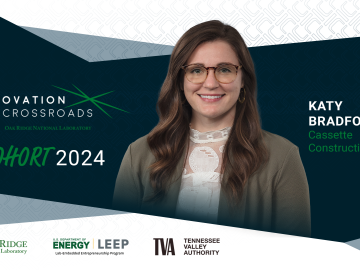
Filter News
Area of Research
News Topics
- (-) Frontier (26)
- (-) Neutron Science (52)
- (-) Partnerships (21)
- 3-D Printing/Advanced Manufacturing (43)
- Advanced Reactors (8)
- Artificial Intelligence (51)
- Big Data (30)
- Bioenergy (51)
- Biology (60)
- Biomedical (31)
- Biotechnology (12)
- Buildings (23)
- Chemical Sciences (27)
- Clean Water (15)
- Climate Change (52)
- Composites (8)
- Computer Science (89)
- Coronavirus (17)
- Critical Materials (5)
- Cybersecurity (14)
- Decarbonization (47)
- Education (2)
- Emergency (2)
- Energy Storage (30)
- Environment (105)
- Exascale Computing (30)
- Fossil Energy (4)
- Fusion (31)
- Grid (26)
- High-Performance Computing (49)
- Hydropower (5)
- Isotopes (31)
- ITER (2)
- Machine Learning (23)
- Materials (45)
- Materials Science (48)
- Mathematics (7)
- Mercury (7)
- Microelectronics (3)
- Microscopy (20)
- Molten Salt (1)
- Nanotechnology (16)
- National Security (47)
- Net Zero (8)
- Nuclear Energy (56)
- Physics (31)
- Polymers (8)
- Quantum Computing (22)
- Quantum Science (32)
- Renewable Energy (1)
- Security (12)
- Simulation (33)
- Software (1)
- Space Exploration (12)
- Statistics (1)
- Summit (32)
- Sustainable Energy (48)
- Transformational Challenge Reactor (3)
- Transportation (27)
Media Contacts

Distinguished materials scientist Takeshi Egami has spent his career revealing the complex atomic structure of metallic glass and other liquids — sometimes sharing theories with initially resistant minds in the scientific community.

Katy Bradford is on a mission to revolutionize the construction industry and is the founder of Cassette Construction, a company in the newest cohort of Innovation Crossroads, a DOE Lab-Embedded Entrepreneurship Program node at ORNL. As an Innovation Crossroads fellow, Bradford and her company will receive technical, financial and networking support to successfully advance the company’s products to the marketplace.

The "SNS LEGO Model Middle School Outreach Program" invites middle school students to build a LEGO model of the SNS, a major scientific accelerator. This engaging initiative aims to teach students about STEM careers and the inner workings of the SNS through hands-on construction and interactive lessons. Launching next spring, the program seeks to inspire interest in science and engineering among young learners.

A group of scientists at the Department of Energy’s Oak Ridge National Laboratory have conducted neutron scattering research to reveal key information about fungus cell membranes that could aid in developing new antifungal treatments.

As a mechanical engineer in building envelope materials research at ORNL, Bryan Maldonado sees opportunities to apply his scientific expertise virtually everywhere he goes, from coast to coast. As an expert in understanding how complex systems operate, he’s using machine learning methods to control the process and ultimately optimize performance.

Nuclear physicists at the Department of Energy’s Oak Ridge National Laboratory recently used Frontier, the world’s most powerful supercomputer, to calculate the magnetic properties of calcium-48’s atomic nucleus.

At ORNL, a group of scientists used neutron scattering techniques to investigate a relatively new functional material called a Weyl semimetal. These Weyl fermions move very quickly in a material and can carry electrical charge at room temperature. Scientists think that Weyl semimetals, if used in future electronics, could allow electricity to flow more efficiently and enable more energy-efficient computers and other electronic devices.

The 26th annual National School on Neutron and X-ray Scattering School concluded on August 9, 2024. Each year, more than 200 graduate students in North America studying physics, chemistry, engineering, biological matter and more compete to participate in NXS. However, given limited space, only 60 can be accepted. The school exposes graduate students to neutron and X-ray scattering techniques through lectures, experiments, and tutorials.

Five researchers at the Department of Energy’s Oak Ridge National Laboratory recently completed an eight-week pilot commercialization coaching program as part of Safari, a program funded by DOE’s Office of Technology Transitions, or OTT, Practices to Accelerate the Commercialization of Technologies, or PACT.

The world’s fastest supercomputer helped researchers simulate synthesizing a material harder and tougher than a diamond — or any other substance on Earth. The study used Frontier to predict the likeliest strategy to synthesize such a material, thought to exist so far only within the interiors of giant exoplanets, or planets beyond our solar system.


